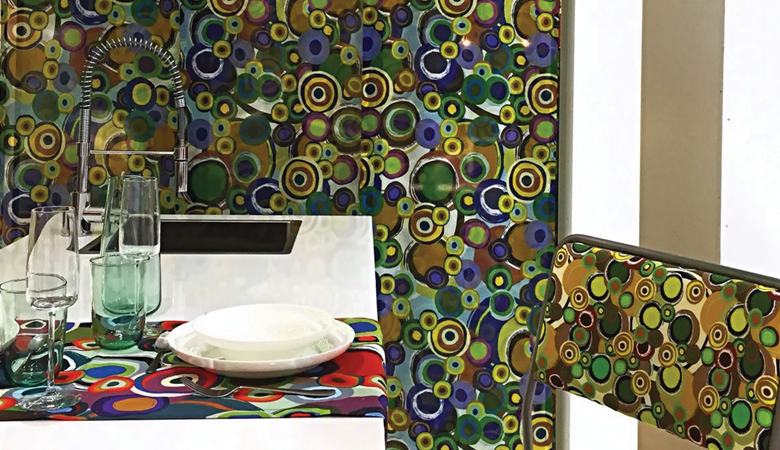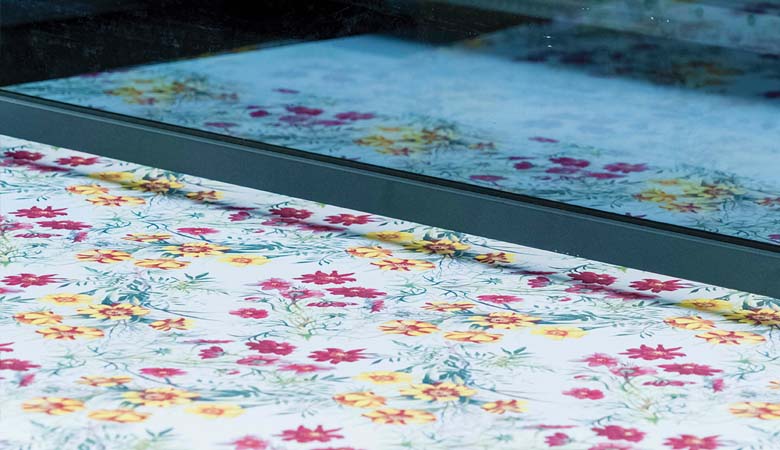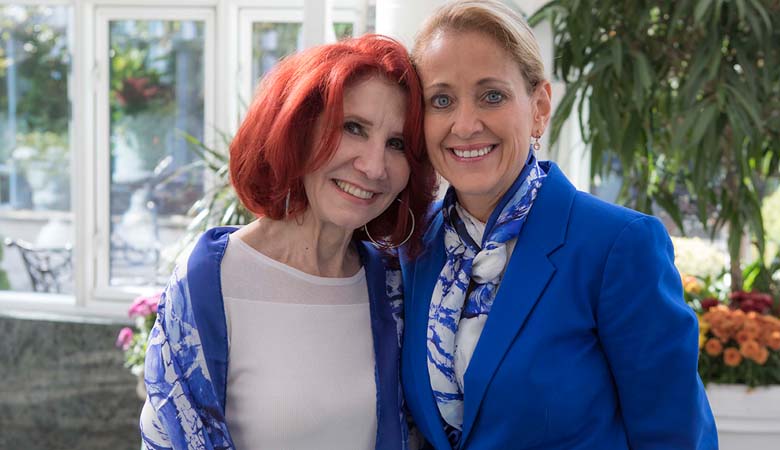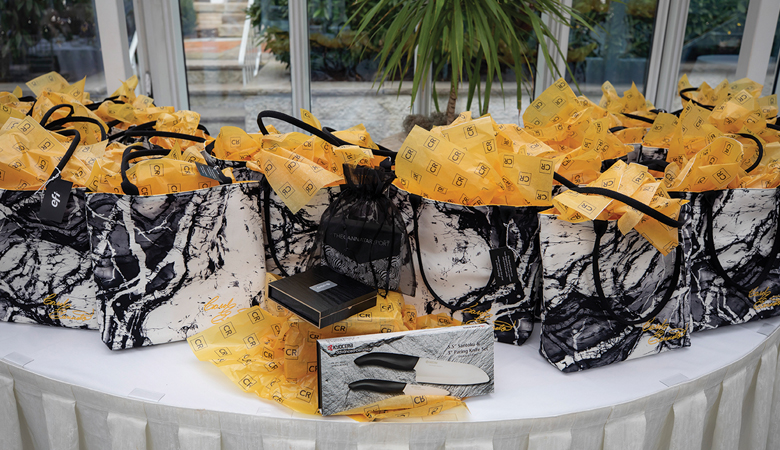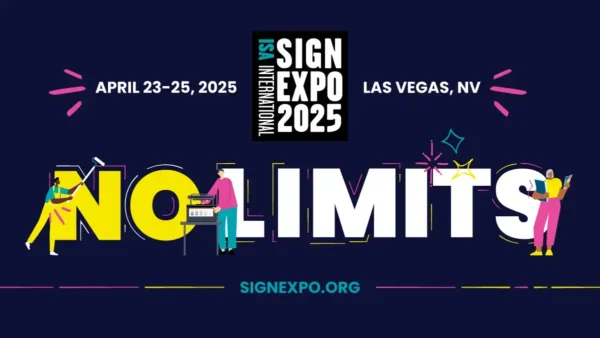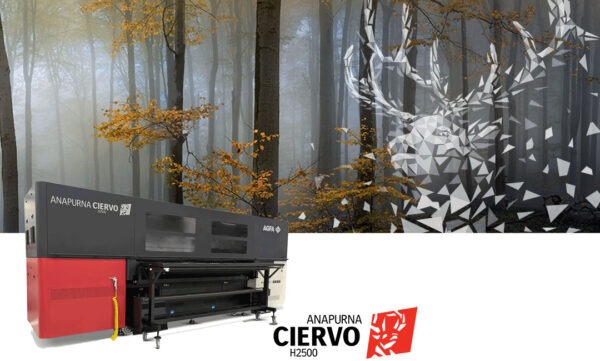Chief Revenue Officer Frank Mallozzi puts textile printing into perspective at ITMA 2019.
Top and above: The EFI Reggiani portfolio brings high-end possibilities to home décor production with digital solutions that increase sustainability while allowing for greater customization and superior color quality.
Initially, Frank Mallozzi, chief revenue officer at EFI, encouraged us to attend ITMA Barcelona 2019, especially since EFI had acquired Reggiani Machine in July 2015. Based in Bergamo, Italy, and established in the 1960s, Reggiani manufactures industrial inkjet printers using water-based inks to print on fabric. (To learn more about ITMA, please read our additional coverage at www.thecannatareport.com).
We sat down with Frank during the conference and immediately came to understand the importance of this event. This was the 18th edition of ITMA, which has grown to become one of the most important global print conferences, second only to drupa.
CR: Why is attending ITMA important?
Mallozzi: It is like drupa in that it is held every four years. Not only are the machines on display, but everything that is needed to produce finished products is also exhibited. Attendees are able to see it all and to talk to the vendors involved in finishing these digitally printed products.
CR: Why is printing on textile such an important market for EFI?
Mallozzi: We believe we are leaders in transitioning print products from analog to digital. The same steps we took for Vuetek, Jetrion, and Creta Print, we are now repeating with Reggiani and Matan.
CR: From a practical standpoint, what percentage of your revenue does it represent?
Mallozzi: It is responsible for 25% of the industrial portfolio. (Editor’s note: We estimate that equates to $275 million.)
CR: Who are the customers for the printing-on-textile market?
Mallozzi: Brands such as Under Armor, Gucci, and Dolce Gabbana are just a very few of potential customers for textile printing. All the sportswear brands are also likely targets for placements.
CR: What are some of the advantages of textile printing?
Mallozzi: You can print on all kinds of materials and even synthetics. The inks used drive various applications. For instance, for silk, you use acid-based inks. We use reactive inks for synthetic fabrics. There is disperse ink and dye sublimation like what is used for soft signage.
CR: Who are the primary competitors?
Mallozzi: Pretty much all the same as we experience in industrial printing””Dover, MS Brand, Durst, and Mamaki on the low end. Reggiani has been competing for high-end placements for 72 years. We are able to compete with the Chinese.
Direct-to-textile printing on EFI Reggiani printers yields high-end printing with vibrant colors on a wide range of fabrics.
CR: Does the printing on textile business translate well into the North American market?
Mallozzi: There is a big shift going on. We are starting to see three seasons. The reason is analog textile production from design to production takes months before you even get to the next season. One season could be still on the ocean, and the manufacturers are in production on the next one. You can go through seasonal changes month by month. Because of this, the supply chain must change. The digital technology must bring the products closer to the shelf. We saw a dramatic shift to China years ago, and it not coming back to us in North America.
CR: In terms of distribution, what is your market strategy? Direct or indirect?
Mallozzi: We have a giant network around the world for many years. Reggiani has been in the business for 72 years, and some who have been representing us for 32 years. We have dealers and distributors in some markets and in North America. We have partners and direct sales.
CR: Will EFI have any Reggiani printers on their stand at Print United in October?
Mallozzi: You’ll most likely see a display of fabric technology that shows a derivative of printing on textile.
CR: Will there be any special focus on printing on textile at Connect 2020?
Mallozzi: It’ll be similar to what we did last year with seminars in commercial packaging, textile, and building materials.
CR: From a global perspective, what are the most important markets for textile printing?
Mallozzi: For textile, there is China, Pakistan, India, Turkey, and Brazil. These are emerging markets that are key to textile. What is interesting is that we are seeing a shift of being greener, cleaner, and sustainable.
CR: Do you see dealers playing a role in this business, and if so, when?
Mallozzi: I do, like any other segment of our business. I see no difference in that in commercial printing products, you have images that require workflow, devices satisfy production”” fairly like what we do today. We see a seamless transition for a deal already engaged in commercial printing.
CR: Are the margins consistent to what dealers are experiencing in production print?
Mallozzi: On the textile side, it is closer to the display side of the business. It is different than what our dealers are used to in office printing technology. There is a post-sale consumable here that delivers a good margin.
CR: Any final thoughts or message you would like to convey to our dealer audience?
Mallozzi: For 35 years, we have experienced the evolution of desktop printing to digital presses. Textile is really no different, and it is an incredible opportunity because it offers customers a solution for many of their problems.
_______________
Designs on the Future
EFI and The Cannata Report have partnered on two unique creations designed by our very own Carol Cannata who has extensive experience in fashion and interior design. Each spotlights fabric printing and its wide-ranging potential. In 2017, Carol collaborated with EFI Reggiani on a luxurious hand-stitched silk scarf. In 2018, she once again worked with the EFI Reggiani creative team in Milan to produce a canvas tote bag with a vibrant-hued lining. Each was presented as a special commemorative gift at The Cannata Report’s Women Influencers Brunch in 2017 and 2018 to underscore the tremendous future potential of the print industry.
For the third consecutive year, Carol is working with EFI Reggiani on a new creation to spotlight printing on fabric. it will be given as a gift to the guests at The Cannata Report’s 2019 Women Influencers Brunch on Friday, November 8, at The Madison Hotel in Morristown, N.J. For more information on this special event, contact cjcannata@cannatareport.com.
Above: Carol Cannata (left) and GreatAmerica’s Jennie Fisher (right) don their scarves at The Cannata Report’s 2017 Women Influencers Brunch. Below: Tote bags created by Carol Cannata and printed by EFI Reggiani were on display and given to guests at The Cannata Report’s 2018 Women Influencers Brunch.
_______________
ITMA 2019 | TEXTILE TRIPLE PLAY (Part 2 of 3): EPSON
Marketing Vice President Fernando Stinchi validates the OEM as a serious textile printing player.
ITMA 2019 | TEXTILE TRIPLE PLAY (Part 3 of 3): HP
Large-Format Production General Manager Joan Perez Pericot outlines HP’s initiatives in textile printing.
Access Related Content
Visit the www.thecannatareport.com. To become a subscriber, visit www.thecannatareport.com/register or contact cjcannata@cannatareport.com directly. Bulk subscription rates are also available.

